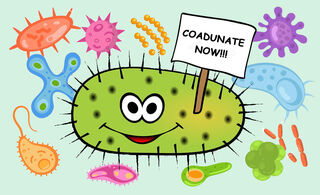Genetics
How Evolution Can Help Us Make Sense of the Insanity
Part I The mechanisms of microbial evolution can help to explain recent events.
Posted February 17, 2021 Reviewed by Lybi Ma

If we wish to make sense of recent political events in America, there’s no better analogy than looking at the microbiology of the Cambrian explosion. This may seem like an odd idea, but if you’ll give me a little leeway, I’ll explain why it’s a perfect analogy. The mechanisms of microbial evolution can help to explain the insanity of horned conspiracy Vikings, mass delusions about election fraud, inadvertent insurrections, everything that happened in January of this year.
One of the most interesting scientific mysteries is the mystery of coadunation – how multicellular life sprang into being on our planet. The very first known single-celled organisms emerged over three and a half billion years ago, and it took a full three billion years of evolutionary processing to produce the very first complex forms of life. This extraordinary microbiological transition was the most pivotal moment in the history of evolution on Earth, and until recently, we had absolutely no idea how it happened. The gulf between unicellular and multicellular life seems quite vast and incomprehensible – there are massive genetic hurdles that must be overcome, to transition to multicellularity.
Unicellular life is simple. Like microscopic hermits, they need only be concerned with feeding themselves, and pretty much just sit there, happily filtering seawater. In contrast, multicellular organisms – from something as simple as four cells in algae to the 37 trillion cells that make a human body – somehow manage to get their constituent cells to yield their independence; take on specialized functions; curtail their own reproduction for the greater good; grow only as much as they need to fulfill their exact function; and develop the abilities to see, to move, to think.
The answer to understanding multicellularity lies in understanding that cooperation is advantageous. Simply put, cells benefit more by working together than they would by trying to make it on their own. This is what powered the transition from unicellular life – which is essentially “looking out for number one” – to multicellular life, in which cells agree to look out for each other.
For example, multicellularity brings mobility for seeking more nutrient-rich habitats, eluding predators, and chasing down prey. Plants can probe deeper into the soil for water and nutrients; they can also grow toward sunny spots to maximize photosynthesis. Fungi can build massive reproductive structures to spread their spores. There are lots of advantages that are possible once you go multicellular.
The Coadunation of Human Society
The point of this scientific tangent is that the paleobiology of multicellularity can be the basis for a new theory of societal coadunation for humans. Consider, for example, this experiment that showed that when certain microbes secreted useful molecules that all members of the group could benefit from, instead of sharing them in a “greedy” fashion, it provided glue for holding that organism together. We can use this bit of research to propose that the societal analogy of “useful molecules” could be money or love… but it needs to be equitably distributed to enable the survival of the multicellular organism. This addresses a key factor in governance models.
When an organism makes the leap to multicellularity, it is by developing gene regulatory capabilities that ensure its cells stop dividing at the appropriate time and function in step with their neighbors. In other words, they have to get along with other cells. Without those molecular constraints, cells will start growing out of control, become greedy and harm their neighbors, and release ancient genes that can resist drugs and treatment. What is really interesting is that the root cause of de-coadunation lies in cells behaving in a way that do not benefit all members of the group – they benefit some, while harm others – these cells are also known as cancer cells.
Actually, this has led to a radical theory of cancer: that cancer could be the process of multicellular organisms rewinding the evolutionary clock to revert into acting like unicellular life. A research group at the MacCallum Cancer Centre in Melbourne, Australia, run by David Goode, a computational cancer biologist, has found evidence to support this theory. They examined gene expression in seven types of solid tumors—including breast, stomach, and liver cancers—and traced the ancestry of the active genes they found. Goode's team reported that genes that date all the way back to early single-celled eukaryotic organisms were activated, whereas, genes unique to many-celled animals had become dormant.
Within this idea is a powerful parallel for societal coadunation: processes that attempt to reverse evolution – ie, that devolve into less multicellular goals – could be thought of as a societal form of cancer. Everything we think of as bad for society – fascism, war, systemic racism, extreme income inequality, climate change denial, the violation of the rule of law by the ruling class – all of these societal issues can be considered to be types of societal cancer, which drive de-coadunation.
But is coadunation communism? No. There’s a brilliant quote by Winston Churchill, “Capitalism is the unequal distribution of wealth. Socialism is the equal distribution of poverty.” Coadunation seeks to optimize the function of the multicellular organism and does this by both ensuring equitable sharing of nutrients and other useful molecules, and rewards performance to enable the fair distribution of ever-increasing wealth. Societal coadunation seeks to balance, but at the same time, it must incent. In multicellular organisms, useful molecules must reward useful work.
The Evolution of Seeing
However, there’s an even better lesson in the Cambrian explosion for understanding societal coadunation: the evolution of sensory function. Fossil evidence suggests that before this point, organisms were either filter feeders or microbial mat grazers. Driven by nutrient scarcity and predation, arthropods took the lead in the evolution of vision and domination in Cambrian communities. They provide the very first fossil evidence of eyes, as well as the subsequent evolution of complex nervous systems after the advent of predation, 550 million years ago.
Again, we may ask, what does this have to do with societal coadunation? If we again draw an analogy between microbiological and societal coadunation, it becomes obvious that the key functionality that society must develop is the ability to see reality accurately. You can assume that some adaptations of vision during the Cambrian explosion were flawed. A sensory adaptation that sent you exactly in the opposite direction of richer nutrients, or right into the jaws of a predator, that mutation would not last very long in the Cambrian sea. Instead, the force of evolution always propels the development of a more sensitive and accurate sensory function.
However, at the societal level, this ability to see or detect danger isn’t between countries or between classes. The best dangers are the ones that address all of humanity as a whole. And so, it may be that the COVID pandemic, which has killed nearly two million people, may actually be a way for humanity to develop better group sensory function, to help us collectively learn how to see reality more clearly. Just as predators forced microorganisms to develop better sensory function, and eventually awareness and memory, it may be that conspiracy theories are simple lessons meant to encourage our society to adapt methods for overcoming them, to create societal sensors that can detect emerging mind viruses, and to drive humanity to evolve and coadunate. In fact, it may be that overcoming a conspiracy theory is in itself, a mechanism that drives societal coadunation.
And that’s the topic of Part II of this series, The R0 of a Conspiracy Theory.




